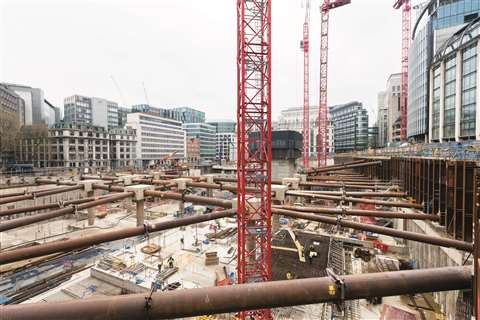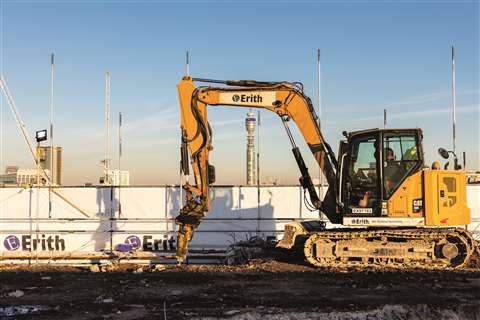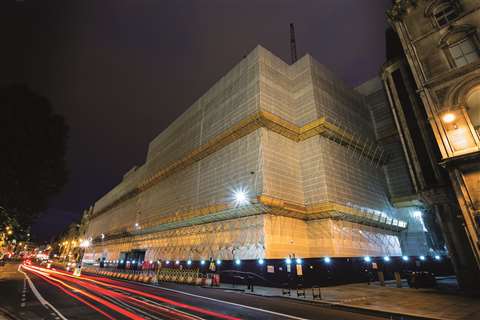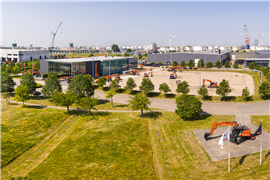From subcontractor to principal contractor: Controlling the construction site
15 June 2022
What is involved when a demolition company steps up to become principal contractor with overall responsibility for the site? British business Erith now does much of its business as main contractor. Operations director Stuart Accleton outlines the main differences in how a project would be executed.
 Aerial short of one of Erith’s project sites in London, UK. (Photo: Erith)
Aerial short of one of Erith’s project sites in London, UK. (Photo: Erith)
When I first started in the business 20 years ago Erith was predominantly a subcontractor.
The process of becoming a principal contractor is that you control the site, you work under your own method statements, they are not guided by main contractor influence and people who may not understand demolishing structures as much as a demolition contractor. It is a massive plus being in charge of your own destiny.
There is a lot more to consider as a principal contractor and a lot more responsibility.
Obviously there is the local authority documentation, which you have to get approved. In my experience with some London boroughs, for instance, lead in times for approvals can be anything from 12 to 20 weeks.
Documentation must be submitted along the lines of the Section 106 planning application agreements and you have to take into account any planning constraints that may be issued against a project.
You have to give detailed information on noise, dust and vibration limits that are going to be produced from the works that you are undertaking – detailed traffic management plans, how you are going to deal with local neighbours with regards to commercial properties and residential especially and how you are going to interact with them.
And also what are you going to do for the local community has become a big planning constraint. How much local employment are you going to have? How much local procurement? What good are you going to do in that local area for all the potential disturbance that you could be causing when undertaking the works?
 Stuart Accleton, operations director at Erith Contractors in the UK. (Photo: Erith)
Stuart Accleton, operations director at Erith Contractors in the UK. (Photo: Erith)
Working with an international client
The standout principal contractor project for us was probably one in London’s Farringdon Street, which we did for a very famous world bank. That was about 10 years ago. It brought us right up to speed with dealing both with the City of London and with an international client who had a very heavy security and safety interest in the project.
I can remember sitting in their offices in central London and having to do health and safety presentations to directors all around the world, in Bangalore, New York, Australia. There would be one person having their breakfast, and another almost falling asleep because it was about two o’clock in the morning their time. That was a project for us that really honed our skills.
Sustainability has really come to the forefront in the last few years as well. Not just health and safety and environmental legislation but the sustainability of carbon offsets, the type of equipment and fuel oils that we are now using and pushing into electric plant.
The reuse of materials is also important now. Obviously there is a big push from architects to say that demolition can cause huge amounts of carbon release.
That was really a project for us that brought us up to an exemplary level of documentation and paperwork and dealing with clients. Project progress meetings were almost daily as opposed to fortnightly or monthly.
From tender stage to completion was nearly two years.
Covid-19 legislation and guidance
More recently, we have had to deal with Covid-19. The differences in doing so as principal contractor are huge compared to being the company that does the demolition. Here are two examples.
For one particular project, we were the sub-contractor to the main contractor which was a joint venture partnership, and their stance was “the site shuts, indefinitely”.
The site literally closed down on the Friday before lockdown and they went into a process of assessing how they could potentially get works back on site, whether it was with reduced numbers or adjusting welfare, and took some 12 weeks to adapt before they would even consider calling two or three of us back to site to discuss how we would go back to work.
 Being principal contractor allows work to continue across various parts of a site. (Photo: Erith)
Being principal contractor allows work to continue across various parts of a site. (Photo: Erith)
Whereas when we were principal contractor, we took a step back at the start of the United Kingdom’s first lockdown and assessed our sites.
We had a limited number of staff in adjusting welfare, putting in one-way walk systems around site and adjusting the welfare areas, so people could sit 2 m (6 ft 6 in) apart, making sure there is plenty of ventilation in those areas, marking out distance markers along the walkways, and setting up hand sanitising stations and introducing more handwashing facilities in excess of what you would require under CDM (the Construction Design and Management regulations 2015).
Within that first five to 10 days, we got all our sites back up and running. We had our own Covid policy which was then reviewed as government legislation and guidance changed through that first lockdown into the second and third lockdowns. And we just kept amending our Covid policy and working policy.
It was never said by the government that construction was a critical working element and that you should go to work, but obviously I think we really kept the country going through lockdown.
Meeting carbon emissions targets
I don’t think that the changes the demolition industry are going through are a shock for principal contractors. I think we have always quietly led the recycling opportunities of buildings. It’s within our nature.
Now it is becoming about increased pressures on reuse, or traceability if items are going off site for recycling, and what they are going to be recycled into.
We have recently secured a project in London where a client has set us a target of 100% carbon neutral.
All plant is to be electric, all deliveries to site will be by electric vehicles. We are looking at recycling plastic materials on site to go into the manufacture of high-vis vests, for instance. We are going through a process now of analysing what type of plastic is in the structure. We have quite a lead in time before the project starts so we can go in and do a lot of analytical work.
The hardest thing is convincing designers and architects to reuse items. They want new shiny steelwork, they want to use products potentially that in years to come don’t fit recycling opportunities.
They make it harder for demolition contractors to deal with in the future. No one is thinking about the end of life of these structures in 50 or 60 years time, and that is where as an industry we need our voice to be heard.
 Erith excavates a site on London’s Baker Street. (Photo: Erith)
Erith excavates a site on London’s Baker Street. (Photo: Erith)
Subcontractor experience
Anyone who takes on a project as principal contractor will have had good and bad experiences of being a subcontractor and I think it stands us in good stead for knowing how they would like to be treated that we can then pass that on to the contractors that we use on site.
We have daily morning briefings, afternoon briefings, and post-job briefings, which I think is critical for planning the following day’s work so problems that occur in the afternoon are not being dealt with the following morning before you go to work. They can be dealt with late afternoon so the next day is planning and that can only help the delivery of the project.
Clients have tuned into the fact that by making a demolition contractor their demolition enabling contractor it allows the site to be split into many different elements.
You are not just knocking a building down to ground level. The site can be split so you are producing material in one area, you can concentrate on a certain section of the building, getting that down earlier and quicker while you are still demolishing at the far end of the site if it’s big enough. it speeds up the overall programme delivery.
I think it’s become the norm in the last 10 years and it is something that we have definitely built our business around providing, and we have gone from that demolition contractor to an enabling contractor with our skills around piling, reduced digs, temporary works, for instance to support the basement, and construction of the basement schemes up to ground level.
Expanding into core construction
And we are now seeing that we are being asked more and more not just to come up to ground level, but we are being given opportunities on frame construction, or at least core construction.
Whilst we are completing basement works the cores can be coming up as well – 10, 12, 15 storeys, whatever they may be. And again, when that comes to hand over to the main contractor, they are picking up a project that is at ground level with the cores constructed as well.
The key thing is not to underestimate the amount of lead-in time that you need for documentation with local authorities and clients. It is all very well jumping in and saying ‘we can start on site in two weeks time’. That is not the case with some local authorities.
For instance, there is one particular local authority in London that before you can even submit a construction management you must have two consultations with local neighbours.
 All of Erith’s principal contractor projects follow two consultations with people in the local area. (Photo: Erith)
All of Erith’s principal contractor projects follow two consultations with people in the local area. (Photo: Erith)
You have to have a clear two-week break where you present the project to them, that has to be documented and two weeks later, or within two weeks, they have the right to come back to you and comment on your document and question your logistics, your noise, dust and vibration proposals, or questions around the site. That all has to be documented again and go in as part of the submission to the local authority.
Enabling contractor: Planning competency
If you have not had that neighbourhood liaison up front, they will not even look at your document. They will just send it back to you and you have lost two or four weeks already. When you have promised a client you are going to be on site in two weeks, you could be five or six weeks behind programme.
Then you have got the 12 to 16 week process of getting your documents signed off. That is the key thing, understanding those constraints.
We all know a client and a project manager who will say always take the shortest programme and I think as a competent demolition enabling contractor we need to be in a position to advise them on those local authority constraints and what they are if they are not aware of them.
CONNECT WITH THE TEAM









